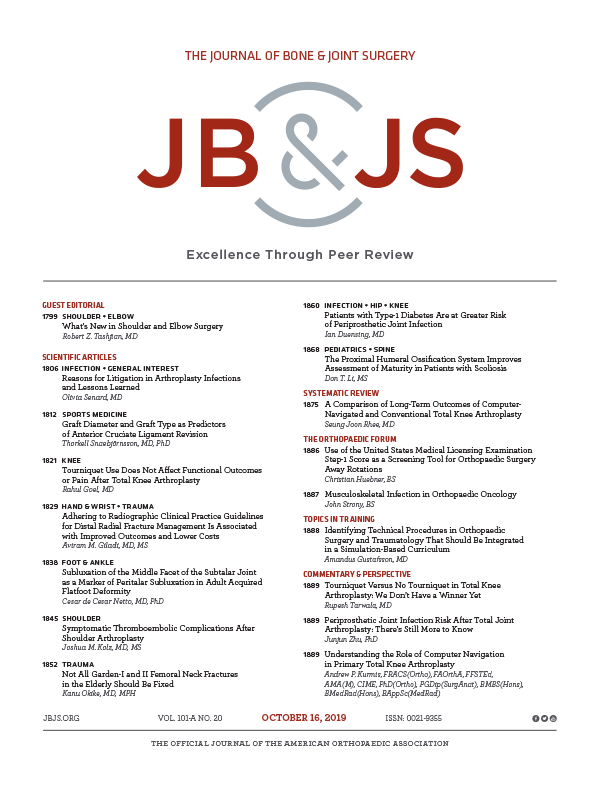
Factors predicting negative outcomes in intramedullary nailing of the tibia

Factors predicting negative outcomes in intramedullary nailing of the tibia
Prognostic factors for predicting outcomes after intramedullary nailing of the tibia
J Bone Joint Surg Am. 2012 Oct 3;94(19):1786-93. doi: 10.2106/JBJS.J.01418.Did you know you're eligible to earn 0.5 CME credits for reading this report? Click Here
Synopsis
1226 patients who were included in the Study to Prospectively Evaluate Reamed Intramedullary Nails in Patients with Tibial Fractures (SPRINT) and completed the 1 year follow-up were included in this study to identify prognostic factors for predicting negative outcomes of this treatment. Multivariable logistic regression analysis identified an increased risk of a negative event for high energy fractures, stainless steel nails vs titanium nails, fracture gaps, full postoperative weight bearing, and open fractures treated with reamed nailing from the 15 baseline and surgical factors investigated.
Was the allocation sequence adequately generated?
Was allocation adequately concealed?
Blinding Treatment Providers: Was knowledge of the allocated interventions adequately prevented?
Blinding Outcome Assessors: Was knowledge of the allocated interventions adequately prevented?
Blinding Patients: Was knowledge of the allocated interventions adequately prevented?
Was loss to follow-up (missing outcome data) infrequent?
Are reports of the study free of suggestion of selective outcome reporting?
Were outcomes objective, patient-important and assessed in a manner to limit bias (ie. duplicate assessors, Independent assessors)?
Was the sample size sufficiently large to assure a balance of prognosis and sufficiently large number of outcome events?
Was investigator expertise/experience with both treatment and control techniques likely the same (ie.were criteria for surgeon participation/expertise provided)?
Yes = 1
Uncertain = 0.5
Not Relevant = 0
No = 0
The Reporting Criteria Assessment evaluates the transparency with which authors report the methodological and trial characteristics of the trial within the publication. The assessment is divided into five categories which are presented below.
3/4
Randomization
4/4
Outcome Measurements
4/4
Inclusion / Exclusion
4/4
Therapy Description
4/4
Statistics
Detsky AS, Naylor CD, O'Rourke K, McGeer AJ, L'Abbé KA. J Clin Epidemiol. 1992;45:255-65
The Fragility Index is a tool that aids in the interpretation of significant findings, providing a measure of strength for a result. The Fragility Index represents the number of consecutive events that need to be added to a dichotomous outcome to make the finding no longer significant. A small number represents a weaker finding and a large number represents a stronger finding.
Why was this study needed now?
The surgical fixation of tibial shaft fractures using intramedullary nail has become common practice, however, the choice between reamed and unreamed intramedullary nails has remained controversial. A recent study (SPRINT) investigated the outcomes of the use of reamed and unreamed intramedullary nails in the treatment tibial shaft fractures. Further assessments of baseline and surgical factors that may influence the risk of negative outcomes were needed to facilitate optimal patient care and guide treatment practices.
What was the principal research question?
Are there prognostic baseline or surgical factors associated with the risk of negative outcomes at 1 year following reamed or unreamed intramedullary nailing of open/ closed tibial shaft fractures?
What were the important findings?
- 1226 patients completed the one year follow-up and were used in the prognostic assessment. 622 patients were treated with reamed intramedullary nails and 604 patients were treated with unreamed intramedullary nails.
- There was an increased risk of negative outcomes in high-energy injuries compared to low energy injuries (OR=1.57 95CI, 1.05 to 2.35) (p=0.03), A similar increase in risk with evident with the use of stainless steel nails compared to titanium (OR-1.52 95CI 1.10 to 2.13) (p<0.01).
- A fracture gap of <1 cm compared to no fracture gap was also associated with a greater risk of negative outcomes (OR= 2.4 95CI, 1.47 to 3.94) (p<0.001), and finally full postoperative weight bearing compared to partial postoperative weight bearing was also associated with a greater risk of negative outcomes (OR=1.63 95CI 1.00 to 2.64) (p<0.048)
- The increased risk associated with full postoperative weight bearing and nail material was attributed to the autodynamization component of the composite score for negative outcomes. Autodynamization rate was 12.8 percent for full weight bearing versus 3.9 percent for partial/non-weight bearing. Autodynamization rate was 2.3 percent with titanium and 10.1 percent with stainless steel.
- Open fracture increased the risk of a negative outcome only for patients who had reamed nailing (OR=3.26 95CI 2.01 to 5.28). Patients who had primary closure or delayed primary closure had a decrease risk of an event compared to those requiring additional soft-tissue reconstruction. (OR=0.18; 95CI, 0.09 to 0.35, and OR= 0.29 CI 0.14 to 0.62 respectively)
- Reamed nailing had a decreased risk of negative outcomes than unreamed for patients with closed fractures (OR=0.60 95CI 0.40 to 0.92) (p=0.02). This relationship was no longer significant with the removal of autodynamization from the composite.
What should I remember most?
The multivariable analysis identified a number of prognostic factors for negative events during the treatment of open and closed tibial shaft fractures. An increased risk of a negative event was found for high energy fractures, stainless steel nails vs titanium nails, fracture gaps, full postoperative weight bearing, and open fractures treated with reamed nailing.
How will this affect the care of my patients?
The findings from this study have identified a number of prognostic factors that may indicate an increased risk of a negative event during treatment of tibial fractures. The findings from this study can assist in identifying the best possible treatment option depending on the characteristics of the injury and instrumentation available.
Learn about our AI Driven
High Impact Search Feature
Our AI driven High Impact metric calculates the impact an article will have by considering both the publishing journal and the content of the article itself. Built using the latest advances in natural language processing, OE High Impact predicts an article’s future number of citations better than impact factor alone.
Continue



 LOGIN
LOGIN

Join the Conversation
Please Login or Join to leave comments.